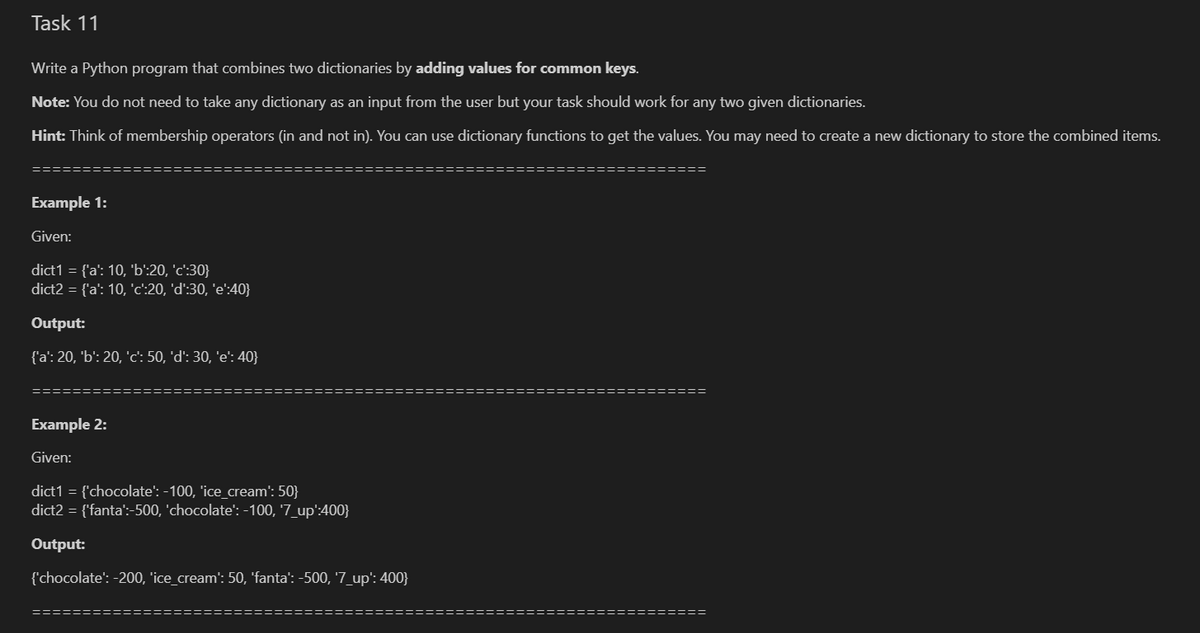Write a Python program that combines two dictionaries by adding values for common keys. Note: You do not need to take any dictionary as an input from the user but your task should work for any two given dictionaries.
Write a Python program that combines two dictionaries by adding values for common keys. Note: You do not need to take any dictionary as an input from the user but your task should work for any two given dictionaries.
Computer Networking: A Top-Down Approach (7th Edition)
7th Edition
ISBN:9780133594140
Author:James Kurose, Keith Ross
Publisher:James Kurose, Keith Ross
Chapter1: Computer Networks And The Internet
Section: Chapter Questions
Problem R1RQ: What is the difference between a host and an end system? List several different types of end...
Related questions
Question
Must show it in Python:
Please show step by step with comments.
Please show it in simplest form.
Please don't use any functions
Please don't use any def func ()
Input and Output must match with the Question
Please go through the Question very carefully.

Transcribed Image Text:Task 11
Write a Python program that combines two dictionaries by adding values for common keys.
Note: You do not need to take any dictionary as an input from the user but your task should work for any two given dictionaries.
Hint: Think of membership operators (in and not in). You can use dictionary functions to get the values. You may need to create a new dictionary to store the combined items.
Example 1:
Given:
dict1 = {'a': 10, 'b':20, 'c':30}
dict2 = {'a': 10, 'c':20, 'd':30, 'e':40}
Output:
{'a': 20, 'b': 20, 'c': 50, 'd': 30, 'e': 40}
Example 2:
Given:
dict1 = {'chocolate': -100, 'ice_cream': 50}
dict2 = {'fanta':-500, 'chocolate': -100, '7_up':400}
Output:
{'chocolate': -200, 'ice_cream': 50, 'fanta': -500, '7_up': 400}
====
======================ニニ========
Expert Solution
This question has been solved!
Explore an expertly crafted, step-by-step solution for a thorough understanding of key concepts.
Step by step
Solved in 5 steps with 2 images

Recommended textbooks for you

Computer Networking: A Top-Down Approach (7th Edi…
Computer Engineering
ISBN:
9780133594140
Author:
James Kurose, Keith Ross
Publisher:
PEARSON

Computer Organization and Design MIPS Edition, Fi…
Computer Engineering
ISBN:
9780124077263
Author:
David A. Patterson, John L. Hennessy
Publisher:
Elsevier Science

Network+ Guide to Networks (MindTap Course List)
Computer Engineering
ISBN:
9781337569330
Author:
Jill West, Tamara Dean, Jean Andrews
Publisher:
Cengage Learning

Computer Networking: A Top-Down Approach (7th Edi…
Computer Engineering
ISBN:
9780133594140
Author:
James Kurose, Keith Ross
Publisher:
PEARSON

Computer Organization and Design MIPS Edition, Fi…
Computer Engineering
ISBN:
9780124077263
Author:
David A. Patterson, John L. Hennessy
Publisher:
Elsevier Science

Network+ Guide to Networks (MindTap Course List)
Computer Engineering
ISBN:
9781337569330
Author:
Jill West, Tamara Dean, Jean Andrews
Publisher:
Cengage Learning

Concepts of Database Management
Computer Engineering
ISBN:
9781337093422
Author:
Joy L. Starks, Philip J. Pratt, Mary Z. Last
Publisher:
Cengage Learning

Prelude to Programming
Computer Engineering
ISBN:
9780133750423
Author:
VENIT, Stewart
Publisher:
Pearson Education

Sc Business Data Communications and Networking, T…
Computer Engineering
ISBN:
9781119368830
Author:
FITZGERALD
Publisher:
WILEY